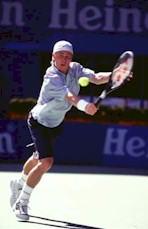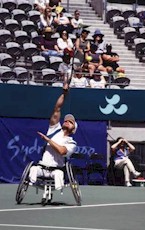 | ||
 |
||
|
| ||
 |
|||||||||||||||||||
Tennis Characteristics of the Sport Tennis is a game of skill, speed, agility, concentration and often endurance. It is played by both men and women, in singles and in doubles competition (same-sex and mixed-sex pairs). At an elite level, tennis is a fast and mobile game, characterised by bursts of intense exercise during rallies. The game is highly reliant on anaerobic energy systems, although a developed aerobic capacity is an advantage in terms of recovery between points, stamina and tolerance to heat. Men's international matches are known to last four or five hours. While the exercise is not continuous for this duration, such a game is likely to challenge the carbohydrate fuel stores of the athlete. Training For professional players, tennis is a full-time job. Between tournaments, 20-40 hours per week may be spent in training - with the majority of this devoted to on-court practice. Most players will supplement this with about an hour per day of off-court conditioning work such as running, weight training and agility work. At the recreational level, training varies with some players using matches as the only training. Competition A tennis match is played over the best of three or five sets for men, and the best of three sets for women. The length of a match varies greatly, from 30 minutes to three hours for a three-set match and from 80 minutes to more than five hours for a five-set match. The fuel and fluid demands of a match will vary accordingly. However, in tournament tennis, the nutritional focus is not so much on the effects of a single match, but on the carry-over effects from playing so many matches in succession. Tournament tennis sets an extremely tough schedule for players, requiring many to play in a singles and doubles match each day until their outcome is decided. Most tournaments require four to six wins to take out the trophy. On average, an elite player participates in twenty tournaments each year. While muscle glycogen levels may survive one match, the continual daily schedule will challenge the athlete to fully recover stores between matches. Depleted muscle glycogen levels will interfere with both sprint and endurance components of performance, and limit the player's ability to perform at an optimum level. Physical Characteristics Having long arms and a relatively low centre of gravity (short legs in proportion to trunk) can facilitate extra reach for playing strokes, greater height for serving and greater mobility around the court. However, tennis players come in all shapes and sizes. Players adapt their game to make the most of their physical strengths. For example, tall, muscular players might use their height and power with an an aggressive serve and volley game, while shorter, agile players may do better with a mobile, court-covering game. In general, the body-fat levels of tennis players are relatively low allowing greater stamina and heat tolerance. Common Nutrition Issues Training Nutrition The training and playing schedules of many elite players set up large energy and carbohydrate requirements. At a lower level of play, carbohydrate needs may not be as great, but may still be beyond the level supplied by the typical Australian diet. Active tennis players need to make nutrient-dense carbohydrate foods such as pasta, rice, bread, cereal, vegetables, fruit and sweetened dairy products the focus of meals and snacks. Players in heavy training need to start recovery nutrition tactics immediately after each training session. Ideally, players should aim to have 50-100 grams of carbohydrate within 30 minutes of finishing training. Recovery snacks should be combined with fluid to replace any fluid lost during the session.
Body-fat Levels Many players, especially females, do not automatically arrive at the body-fat level that does them justice on the court. Being overweight will reduce speed and stamina, and increase suffering during hot days on the court. The first step to reducing body fat is to forget methods claiming to be magic or miraculous and adopt a consistent, long-term approach to body fat maintenance. Try the following:
Fluid Intake During Matches and Training Tennis is often played in sweltering conditions. Court surface temperatures of 500C have been reported from centre court during the Australian Open. When matches drag out to three hours or more players can amass large sweat losses. Fluid losses can also be quite large during training sessions. However, fluid intake can be less as players are not prompted to drink by change of ends as they are during matches. The following sweat loss and fluid intake data has been reported for Division I American University tennis players during singles matches.
Source: Bergeron MF et al. Fluid-electrolyte balance associated with tennis match play in a hot environment, IJSN, 1995, 5: 180-93. Tips for better drinking during tennis are:
Tournament Tennis Tournament tennis is challenging from many nutritional viewpoints. Apart from the considerations of being away from home - even for a weekend tournament - the tournament schedule places great demands on nutritional strategies for recovery, and on a player's flexibility and ingenuity. Not only must a player be committed to looking after fluid and carbohydrate needs between matches, but they must do so without a definite time-table of their day's activities. Since each day's match draw is determined by the results of the previous day's play, players receive short notice about their daily schedule. Forward planning is also made difficult by the loose nature of the daily timetable. While the starting time for the first match of each session can be set, all other matches simply follow in succession. Given the great range of duration of matches, it is often difficult for a player to predict accurately the time of their matches. Tournament players must learn to be adaptable with their eating plans - having a clear idea of the goals of competition nutrition, but being prepared to handle all possible outcomes in a day's play. Life on the Circuit Elite tennis players can look forward to a life of travelling - around Australia and around the world. While this can be exciting, it can also be stressful. It is often hard to meet nutritional needs in unfamiliar surroundings, especially when time and finances are limited. Unusual foods, different standards of food hygiene, limited food availability and interference with usual routines can see athletes either gaining weight or failing to meet their nutritional requirements. The following tips may help:
Case Study Sue was sure that she knew her nutritional goals for competition, but turning theory into practice in tournament tennis was a difficult task. Difficulties arose because of the loose and unpredictable time-table of events. The day's match schedule was variable, crude and given at short notice. Unless Sue was drawn for the first match on each court, she could not be sure of the time she was playing. While she could predict an approximate time for matches, there was never the certainty of a fixed time-table. This made it difficult to time the pre-match meal or to know what to have between matches on the same day. Sue remembered back to a disastrous experience when she was scheduled for the third match of the afternoon, and had eaten a reasonable lunch just before the start of the session. Not only was the first match a one-sided affair lasting 35 minutes, but the second match was forfeited after five minutes due to an injury to one of the players. Suddenly, Sue found herself on the court, with a fuller stomach than she would have liked. Sue took her problems to a sports dietitian who suggested that two strategies were needed to handle the situation. The ideal preparation would be a light meal about 2-21/2 hours pre-match, followed by a warm-up hit and perhaps a top-up with extra fluid before the match. Matches set to a definite schedule, such as the first match in a session, could be tackled in this fashion. When the timetable was uncertain, liquid meal supplements such as Sustagen Sport could be used. Being easy to digest, these could supply a nutritious, carbohydrate-based meal without the discomfort of solid food. This would be handy between two matches close together, or as a top-up to an earlier meal when the next match was running late. They could also be used as a quick snack after a game or a boost to turn a sandwich snack into a more filling meal.
You will find more information about tennis at the
Australian Institute of Sport on the
|
| ||||||||||||||||||
|
The Department of Sports Nutrition is a program of the
Australian Institute of Sport General enquires can be emailed to: aisnutrition@ausport.gov.au Copyright
© Australian Sports Commission
| |||||||||||||||||||




